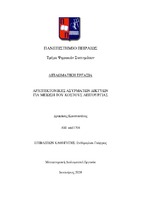Αρχιτεκτονικές ασύρματων δικτύων για μείωση του κόστους λειτουργίας

Προβολή/
Λέξεις κλειδιά
Αρχιτεκτονικές ασύρματων δικτύων ; Αρχιτεκτονικές νέας γενιάς ; SWOT analysisΠερίληψη
Η παρούσα διπλωματική εργασία μελετάει τα ασύρματα δίκτυα τα οποία δημιουργήθηκαν ως επέκταση των ενσύρματων δικτύων, για να επεκτείνουν τις δυνατότητες και την κάλυψη αυτών, σε σημεία όπου δεν είναι δυνατή η ενσύρματη ζεύξη, αλλά και τη διασύνδεση συσκευών που δεν υποστηρίζουν ενσύρματη σύνδεση, παρά μόνο ασύρματη. Τα ασύρματα δίκτυα από όταν αναπτύχθηκαν συνδέθηκαν άμεσα με τις αρχιτεκτονικές οι οποίες τα δομούν και τα οργανώνουν. Στο πρώτο κεφάλαιο, αναφερόμαστε στις αρχιτεκτονικές οι οποίες εφαρμόζονταν στο παρελθόν και αποτελούσαν τεχνολογικά επιτεύγματα για την εποχή εφαρμογής τους. Κάποιες από αυτές εφαρμόζονται ακόμη και σήμερα για διάφορους λόγους (π.χ. κόστος αναβάθμισης, συμβατότητα εξοπλισμού, κ.α.). Βέβαια, καθώς η τεχνολογία εξελίσσεται και αυξάνονται οι ανάγκες γύρω από τα ασύρματα δίκτυα, είναι αναγκαίο να αλλάξουν και οι αρχιτεκτονικές τους. Επομένως, στο δεύτερο κεφάλαιο αναφερόμαστε στην κατηγορία των αρχιτεκτονικών νέας γενιάς όπως οι αρχιτεκτονικές network slicing, cloud-RAN, small cells, relays, cognitive radio, NFV τις οποίες αναλύουμε, παρουσιάζοντας πλεονεκτήματα και μειονεκτήματα αυτών, τον τρόπο εφαρμογής και τις δυνατότητές τους. Οι περισσότεροι πάροχοι πλέον (ειδικά στα δίκτυα νέας γενιάς 5G) ξεκινούν το στήσιμο των υποδομών τους με την εφαρμογή αυτών των αρχιτεκτονικών. Στο τρίτο κεφάλαιο θα εφαρμόσουμε ανάλυση SWOT σε καθεμία από αυτές, ώστε να καταλήξουμε σε αυτές τις αρχιτεκτονικές οι οποίες με την εφαρμογή τους οδηγούν σε μείωση του κόστους λειτουργίας ενός ασύρματου δικτύου και στην αύξηση των δυνατοτήτων του.Τέλος, στο τέταρτο κεφάλαιο, δίνονται συμπεράσματα για τις αρχιτεκτονικές νέων δικτύων τα οποία έχουν προκύψει από το βασικό εργαλείο σε οικονομικές μελέτες και σε μελέτες επενδύσεων SWOT analysis.


